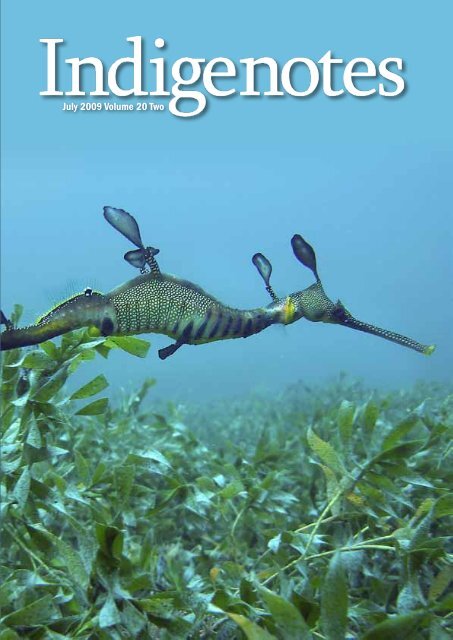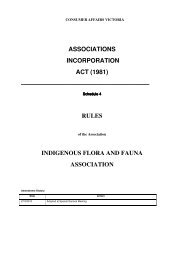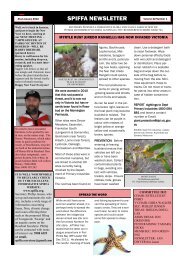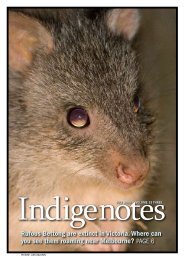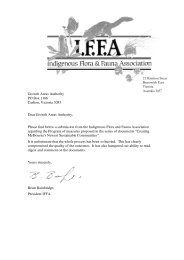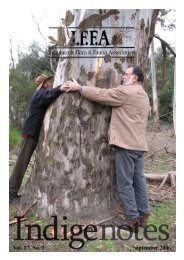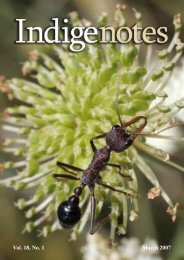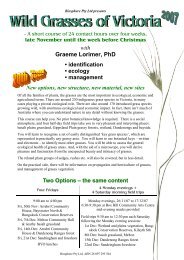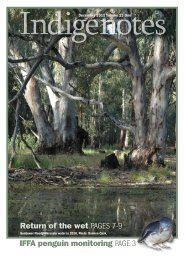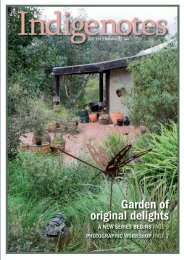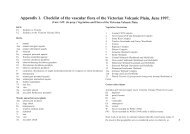July 2009 Volume 20 Two - Indigenous Flora and Fauna Association
July 2009 Volume 20 Two - Indigenous Flora and Fauna Association
July 2009 Volume 20 Two - Indigenous Flora and Fauna Association
Create successful ePaper yourself
Turn your PDF publications into a flip-book with our unique Google optimized e-Paper software.
<strong>July</strong> <strong><strong>20</strong>09</strong> <strong>Volume</strong> <strong>20</strong> <strong>Two</strong><br />
INDIGENOTES VOLUME <strong>20</strong> NUMBER 2
Wedge-tailed Eagle at Tooradin,<br />
<strong>July</strong> 10, <strong><strong>20</strong>09</strong>. Pictures: Liss Ralston<br />
President’s letter<br />
The field day at Harkness Road Gilgai Woodl<strong>and</strong> reminded me of<br />
the utter joy to be had in sharing time with similarly interested<br />
individuals in the bush. Despite the extreme wind chill, the sheer<br />
thrill of people eager to learn, share recollections <strong>and</strong> witness the<br />
bush in all its moods was infectious. My camera — usually reserved for strictly<br />
non-human subjects, was drawn towards the brightly coloured parkas, beanies<br />
<strong>and</strong> the rapt expressions of my fellow expeditioners.<br />
The subject of our day, bullants, was an opportunity for sharing vivid<br />
childhood experiences. I was reminded of poking the nest in the nature-strip as<br />
a child, my stomach churning with delicious terror as huge ants erupted with<br />
unbelievable ferocity, chasing me several metres back up the driveway. Other<br />
attendees shared similar stories, including a gruesome game of ‘chicken’ which<br />
involving st<strong>and</strong>ing on a Meat Ant nest until the loser could no longer st<strong>and</strong><br />
the stings of the angry insects (don’t try this one at home, kiddies!).<br />
I met several characters whose environmental acheivements have made their<br />
names familiar. From the number of cameras <strong>and</strong> notebooks whirring away, I<br />
have no doubt the event will have a ‘multiplier effect’ as these people pass on<br />
their new found expertise.<br />
The day’s success reflected the coordination by Melton’s Environmental<br />
Education Officer (<strong>and</strong> IFFA’s events coordinator) Linda Bradburn, the<br />
expertise of John Wainer <strong>and</strong> enthusiasm of fellow participants <strong>and</strong> Friend’s<br />
groups. Brimbank Council <strong>and</strong> the Werribee CMA should be commended for<br />
their part-subsidy that allowed all this to happen for just a modest financial<br />
outlay by the participants<br />
As proud as I am of IFFA’s blooming website <strong>and</strong> our beautiful newsletter,<br />
events like these remind me of how the virtual <strong>and</strong> the solitary, pales beside<br />
shared human experience in nature.<br />
So, to paraphrase an old slogan, (wild)Life — Be in it!<br />
Brian Bainbridge<br />
2<br />
On the website<br />
http://www.iffa.org.au<br />
Melbourne’s newest<br />
[un]sustainable communities<br />
Read about the biggest l<strong>and</strong>-grab for<br />
developers <strong>and</strong> the impact on native<br />
vegetation to the north, west <strong>and</strong> southeast<br />
of Melbourne. Submissions closed on 17<br />
<strong>July</strong>, but there is more opportunity to be<br />
involved.<br />
IFFA’s Plants <strong>and</strong><br />
Animals Wiki<br />
Over 100 indigenous plant species <strong>and</strong><br />
60 indigenous animal species are now<br />
described on IFFA’s Wiki. The power of the<br />
Wiki is that it allows anyone interested to<br />
contribute their knowledge of the use of<br />
indigenous species <strong>and</strong> their photography<br />
to this joint enterprise. We are especially<br />
interested in building its capacity to<br />
illustrate the inter-relationships between<br />
indigenous plants <strong>and</strong> animals.<br />
At the moment it has a Victorian Volcanic<br />
Plains flavour because of the fantastic<br />
efforts of our President Brian Bainbridge.<br />
But as it grows, we anticipate that<br />
other bioregions will be included. Your<br />
contributions are welcome.<br />
INDIGENOUS FLORA AND FAUNA ASSOCIATION INC
A load of Bullants<br />
On a dull, frigid June morning<br />
as a bitter wind scythed through<br />
thin Greybox <strong>and</strong> Yellow Gum<br />
trunks, nearly twenty hardy<br />
Myrmecophiles* converged on<br />
Harkness Road Gilgai Woodl<strong>and</strong>,<br />
Melton.<br />
The y were drawn by<br />
the promise of meeting<br />
‘Myrmecia species 17’<br />
a bullant<br />
listed under<br />
the FFG <strong>and</strong> EPBC<br />
legislation. Our leader, John<br />
Wainer, an ant expert from the Department of Primary<br />
Industry has had a long acquaintance with this species.<br />
The site contains a distinctive variant of the Plains<br />
Woodl<strong>and</strong> EVC (Walters <strong>and</strong> Frood, <strong>20</strong>04) with an<br />
understorey of various Chenopods (the Saltbush family).<br />
Once proposed for a regional cemetery, the 33.4 hectares<br />
has now been re-allocated to the protection of its unique<br />
biodiversity.<br />
John began with some history on our quarry. Bullants<br />
are a uniquely Australian group of ants which retain several<br />
primitive features. Myrmecia sp 17 was first identified by the<br />
late Jenny Barnett on the nearby Long Forest 32 years ago.<br />
The species has remained un-named since, a consequence of<br />
the lamentable lack of ant taxonomists. The suggestion that<br />
the ant’s name might one day commemorate Jenny <strong>and</strong> her<br />
contribution to conservation was warmly received by the<br />
assembly.<br />
In the reserve, a likely nest was soon found <strong>and</strong> John<br />
demonstrated the unsubtle method of stomping loudly near<br />
the entrance to see if anyone were home. No ants responded.<br />
‘Too sensible to get out of bed’ was the consensus of the<br />
shivering human onlookers. A second nest yielded a single<br />
reddish browny bullant — Myrmecia sp. 17! Although minus<br />
one leg, the individual was bundled into a<br />
viewing jar where it was intensely examined<br />
<strong>and</strong> photographed like a diminutive Paris<br />
Hilton.<br />
The crowd could<br />
smell ichor (insect<br />
‘blood’) <strong>and</strong><br />
began to<br />
scatter across<br />
the woodl<strong>and</strong>,<br />
soon discovering<br />
further nests.<br />
Ian Faithfull bravely<br />
allowed an ant to attack<br />
his thick leather gloves. It<br />
used its huge jaws to get a<br />
hold while aiming its sting with<br />
Dalek-like tenacity.<br />
John was particularly keen to locate the<br />
nest of a close relative of species 17, Myrmecia<br />
nigriceps. When M. nigriceps were duly found,<br />
even John struggled to separate the two<br />
very similar ants. M. nigriceps is somewhat<br />
brighter red than ‘17’ with a slightly duller<br />
‘gaster’ (the bulbous final segments of<br />
the abdomen) <strong>and</strong> the head is a smidge<br />
blacker. John then led the search<br />
for further Myrmecia species, soon<br />
locating a few nests of Myrmecia<br />
pyriformis, a h<strong>and</strong>some allblack<br />
species with shiny red<br />
jaws. Maintaining a flow<br />
of fascinating facts, John<br />
discussed partitioning<br />
of resources, that allow<br />
several related ant species to inhabit<br />
the same area. Such research has led to important techniques<br />
using ant assemblages as indicators of biodiversity. Myrmecia,<br />
although tolerant of disturbance, are dependant on treed<br />
habitats <strong>and</strong> are slow to recolonise deforested sites due to low<br />
reproductive rates.<br />
Other ants included Meat-ants, Iridomymex purpureus,<br />
with their huge gravel strewn nests <strong>and</strong> two kinds of the<br />
mid-size Camponotus (Honeypot) ants.<br />
Myrmecia nigriceps<br />
Species 17<br />
INDIGENOTES VOLUME <strong>20</strong> NUMBER 2 3
Towards the end of the walk, some of us lifted our heads long<br />
enough to glimpse woodl<strong>and</strong> birds including Scarlet Robins,<br />
Brown Tree-creepers <strong>and</strong> a flock of Varied Sittellas. The last<br />
allowed a comparison of their habit of cork-screwing down the<br />
trunk in search of insects in contrast with with the Tree-creepers,<br />
which starts at the bottom <strong>and</strong> works upwards.<br />
It was an absolute delight to be a part of this respectful,<br />
knowledgeable group as it continually budded off side-groups to<br />
investigate flora <strong>and</strong> other fauna. In following days, John Wainer<br />
generously followed up his walk with confirmation on species<br />
identification <strong>and</strong> extra pointers for following up questions.<br />
Four absorbing hours later we shared a convivial (if chilly)<br />
lunch beside Harkness Road before we hastening into our<br />
vehicles <strong>and</strong> leaving the bullants of Melton in peace.<br />
Report: Linda Bradburn<br />
Pictures: Brian Bainbridge<br />
*Myrmecophilia (appreciation of ants)<br />
John Wainer’s investigation of Species 17<br />
http://medusa.jcu.edu.au/crozier/croziergrouphome/<br />
rosspage/myrmeciatheses/Wainer1996Report.pdf<br />
Friends of Toolern Creek<br />
http://www.fotc.com.au/<br />
Jenny Barnett’s 1977 thesis introducing<br />
17 (as Myrmecia sp. 10)<br />
http://medusa.jcu.edu.au/crozier/<br />
croziergrouphome/rosspage/<br />
myrmeciatheses/Barnett1977thesis.<br />
pdf<br />
Varied Sitella. Walters, Bryan<br />
<strong>and</strong> Frood, Doug <strong>20</strong>04 Assessment of Natural Values<br />
at Harkness Road, Melton.<br />
Unpublished report for RJ Wigg, Department of Human Services.<br />
Varied Sittella<br />
Darryl Ackers<br />
— an expert<br />
at reading<br />
his local<br />
l<strong>and</strong>scape<br />
around<br />
Melton.<br />
Ian Faithfull’s<br />
glove bears<br />
the wrath of<br />
17’s jaws <strong>and</strong><br />
sting<br />
4<br />
INDIGENOUS FLORA AND FAUNA ASSOCIATION INC
One day under Flinders jetty<br />
It was the last day in Australia for Rhonda, an exchange ranger from Canada, <strong>and</strong> the<br />
plan was to see one of Victoria’s state emblems — the Weedy Seadragon<br />
The late April weather wasn’t promising — a blustery<br />
day with ragged clouds running across the sky. However, the<br />
wind was from the north <strong>and</strong> Flinders jetty, a known lurking<br />
spot of these Southern Australian marine creatures, would be<br />
relatively sheltered.<br />
We agreed to all meet at Flinders jetty, on the Western Port<br />
Bay side of the Mornington Peninsula, having seen Weedy<br />
Seadragons there previously (both by snorkelling – a lucky<br />
chance, I think – <strong>and</strong> using scuba gear). After a leisurely cup<br />
of hot chocolate <strong>and</strong> with one eye on the weather, we geared<br />
up <strong>and</strong> started down the jetty.<br />
The water was surprisingly clear <strong>and</strong> calm, <strong>and</strong> the marine<br />
life covering the pier legs extraordinary in its variety of shapes,<br />
colours <strong>and</strong> sizes. Ascidians <strong>and</strong> sponges in a dazzling array.<br />
The more we looked, the more we saw. Unfortunately, I<br />
couldn’t begin to put names to these – in the end, I could<br />
only play “art appreciation” not “marine biologist”.<br />
As we moved further towards the end of the jetty, we<br />
started to see our quarry.<br />
These dainty, timid creatures swim slowly <strong>and</strong> gracefully,<br />
<strong>and</strong> are surprisingly difficult to photograph. They much<br />
prefer to face the camera, keeping an eye on possible danger,<br />
rather than turning sideways where their amazing colour<br />
pattern of orange-red background, bright blue stripes <strong>and</strong><br />
many white spots <strong>and</strong> yellow markings can be admired. Tiny<br />
fins are found on either side of their head for balance <strong>and</strong><br />
a long shimmering dorsal fin along their back propels their<br />
body through the water. They are not strong swimmers <strong>and</strong><br />
are often found washed ashore after storms. However, they<br />
do have a surprising turn of speed just when you have them<br />
perfectly framed to photograph!<br />
Long leaf-shaped flaps of skin protrude from stalk-like<br />
bony projections at intervals along the top <strong>and</strong> bottom of<br />
IFFA EVENT<br />
Global Financial Crisis? No, Global Environmental Crisis!<br />
Presented by Dr Roger N Jones. 2pm Sunday 30th August<br />
Climate is changing faster than anticipated, <strong>and</strong><br />
even if the world manages to reach a peak in<br />
emissions <strong>and</strong> global population around <strong>20</strong>50,<br />
the world is likely to have a population of about<br />
9 billion <strong>and</strong> be 2°C warmer than pre-industrial<br />
temperatures.<br />
In Victoria since 1996, climate has already reached levels<br />
of change that were projected for <strong>20</strong>30-<strong>20</strong>50. Ecosystems<br />
are responding to that change — wetl<strong>and</strong>s <strong>and</strong> floodplain<br />
ecosystems are under severe stress, tree dieback is<br />
widespread in grassy ecosystems <strong>and</strong> woodl<strong>and</strong> <strong>and</strong> wetl<strong>and</strong><br />
birds are in decline. We are facing a global ecological<br />
crisis. The world’s ecosystems underpin everything: our<br />
economy, human livelihoods <strong>and</strong> environmental security.<br />
This is green infrastructure. If we look at the current<br />
investment in this infrastructure, it is being allowed to<br />
decline to well below sustainable levels. However, by better<br />
the body, <strong>and</strong> as well as looking like seaweed, their similar<br />
swaying motion as seaweed in the water current makes them<br />
difficult to spot.<br />
Luckily, Flinders jetty is something of a haven for them<br />
<strong>and</strong>, particularly in winter <strong>and</strong> in their spring breeding time,<br />
large numbers gather in the shelter provided by the pier.<br />
The males (like sea horses) carry the eggs for up to 2 months<br />
before the baby seadragons hatch as miniature versions of the<br />
adults, just 2.5 centimetres long.<br />
Weedy seadragons can grow up to 46cm long <strong>and</strong> live for<br />
up to 10 years. They eat plankton, sea lice, larval fishes <strong>and</strong><br />
small shrimp-like crustaceans called mysids.<br />
Along with pipe fish <strong>and</strong> seahorses (which can also be<br />
found at Flinders jetty – although we didn’t see any today),<br />
they are members of the Syngnathidae family. They are<br />
found only along the coast line of southern Australia usually<br />
in shallow water (up to 50m deep) mainly inhabiting kelp<br />
forests, reef edges, seagrass meadows <strong>and</strong> seaweed beds.<br />
We saw our ones in 2 metres of water in the seaweed bed<br />
alongside the jetty.<br />
The Weedy Seadragon was selected as Victoria’s official<br />
marine faunal emblem by public nomination in <strong>20</strong>02, <strong>and</strong> is<br />
fully protected under the Victorian Fisheries Act 1995.<br />
The aim of the day was met, with Rhonda’s experience<br />
of Victorian flora <strong>and</strong> fauna rounded out with the intricate,<br />
beautiful marine life on our rocky shores.<br />
The Canadian ranger saw her Weedy Seadragons,<br />
Phyllopteryx taeniolatus, <strong>and</strong> Parks Victoria ranger Jono<br />
Stevenson filled in the marine biology side for us all.<br />
Jo James<br />
OVERLEAF: A beautiful pictorial record of the day<br />
underst<strong>and</strong>ing ecological processes <strong>and</strong> how they maintain<br />
this infrastructure, we can learn how to build resilience into<br />
adaptation planning. It is time that departments of finance<br />
<strong>and</strong> treasury became interested in green infrastructure. We<br />
need a business plan for ecosystems.<br />
Dr Roger N Jones, previously with CSIRO, is now Professorial<br />
Research Fellow of the Centre for Strategic Economic Studies,<br />
Victoria University.<br />
2pm Sunday 30th August at Victoria University City Campus,<br />
300 Flinders Street Melbourne (opposite Flinders Street<br />
Station) 11th floor room 1101.<br />
Don’t forget you can buy a Sunday Saver Metcard for $3.10<br />
that will get you there <strong>and</strong> back again on public transport<br />
from anywhere in Melbourne.<br />
All welcome. Enquiries to Michele Arundell,<br />
phone (03) 9755 3347 or email michelearundell@yahoo.com<br />
INDIGENOTES VOLUME <strong>20</strong> NUMBER 2 5
1<br />
Jo James & Jono Stevenson<br />
One<br />
day<br />
2<br />
3 4 5<br />
under Flinders jetty<br />
6<br />
INDIGENOUS FLORA AND FAUNA ASSOCIATION INC<br />
6<br />
7
8 9<br />
10 11<br />
12<br />
1 Weedy Seadragon, Phyllopteryx taeniolatus.<br />
Jo James<br />
2 Jetty pile invertebrates. JJ<br />
3<br />
Feather Duster Worm, Sabellastarte sp.<br />
Jono Stevenson<br />
4 Sessile invertibrates. JJ<br />
5 Ornate Cowfish, Aracana ornata. JJ<br />
6 Smooth Back Ray, Dasyatis brevicaudata. JJ<br />
7 Cauliflower Ear<br />
8 White Striped Anemone,<br />
Anthothoe albocinta. JS<br />
9 Southern Goatfish, Upeneichthys vlamingii. JS<br />
10 Short tailed Nudibranch,<br />
Ceratosoma brevicaudatum. JS<br />
11 Jetty pile invertebrates. JJ<br />
12 Juvenile Victorian Scalyfin, Parma victoriae. JJ<br />
13 Draughtboard Shark eggcase. JS<br />
14 Purple Urchin, Heliocidaris erythrogramma. JS<br />
INDIGENOTES VOLUME <strong>20</strong> NUMBER 2 7<br />
13 14
Monash Uni indigenous food garden<br />
I<br />
am truly blessed. For, although I work in the lightindustrial<br />
heartl<strong>and</strong> of Melbourne’s South Eastern<br />
suburbs, it is also home of the Clayton campus of<br />
Monash University.<br />
In the midst of the grounds is a small oasis. Located near<br />
the Halls of Residence <strong>and</strong> the Lake, lies the indigenous<br />
garden. It is here that it is my privilege to walk each day. I<br />
like the early morning best. As the students pass me, they<br />
are seemingly oblivious to the natural wonder <strong>and</strong> beauty of<br />
their surroundings.<br />
The garden itself is pleasantly laid<br />
out on the hill between the Loop<br />
Road <strong>and</strong> the Lake. It has a wonderful<br />
collection of indigenous plants, neatly<br />
labelled with their name <strong>and</strong> the<br />
purpose to which they were put by the<br />
local Aboriginal people.<br />
Some examples include:<br />
Kabin: Running Postman, Kennedia<br />
prostrata. Flower-honey; stem tying.<br />
Warpur: Native Willow,<br />
Pittosporum phillyreoides.<br />
Seed <strong>and</strong> gum can be eaten.<br />
Gurgudj: Ruby Saltbush,<br />
Enchylaena tormentosa. Fruit eaten.<br />
Ngoor-le: Coast Beard-heath,<br />
Leucopogon parviflorus (right).<br />
Fruit eaten.<br />
To the west, at the top of the hill, lies a huge tree trunk on<br />
it side. There is an interesting shape cut into it. The nearby<br />
sign says “The scar on this tree was created a long time ago<br />
by the Wurundjeri balluk people of the Yarra Valley when<br />
they cut out a piece of the bark to make a shield. The tree was<br />
recently donated by the Wurundjeri people.”<br />
Aside from the plants, the area is a magnet for a variety<br />
of birds. Recently there have been Little Pied Cormorants,<br />
Straw-Necked Ibis, a White Faced Heron as well as the usual<br />
quota of common ducks etc. The last week has seen a flock<br />
of Rainbow Lorikeets making a<br />
cacophony in the trees above the<br />
lake.<br />
If you are in the area <strong>and</strong><br />
have a spare moment I invite<br />
you to come <strong>and</strong> take a look<br />
<strong>and</strong> enjoy the sights <strong>and</strong> sounds<br />
of this little piece of heaven.<br />
(Melways 575)<br />
Perhaps other members<br />
would care to share their<br />
favourite spot?<br />
Finally I would like to thank<br />
Beth Gott for all her efforts in<br />
making this garden happen.<br />
Lawrie Hanson<br />
8<br />
INDIGENOUS FLORA AND FAUNA ASSOCIATION INC
Frogs<br />
in Melton<br />
Whistling Treefrog<br />
Melton has an enviable <strong>and</strong> quite distinct diversity of frogs, despite being in the drier<br />
western region of Melbourne <strong>and</strong> despite its status as one of the fastest growing<br />
municipalities. Seven species have been recorded in the Melton area so far.<br />
In <strong>20</strong>08, after a long dry spring, Melton waterways were<br />
dry; consisting of small isolated waterholes separated<br />
by stretches of dry, parched creek bed. Early December<br />
suddenly brought a weekend of dramatic rains. Creeks<br />
ran high <strong>and</strong> local wetl<strong>and</strong>s that had been long empty<br />
were filled with water. Waterways that had been silent were<br />
suddenly loud with frog calls. This meant it was a good time<br />
for Melton Environment Group to record frog calls for the<br />
Melbourne Water Frog Census.<br />
Three common frog species, Pobblebonks, Common<br />
Froglets <strong>and</strong> Spotted Marsh Frogs, were calling loudly in<br />
numerous localities around Melton. The Pobblebonks were<br />
particularly conspicuous, giving their loud territorial “growl”<br />
<strong>and</strong> grappling aggressively with each other in the submerged<br />
vegetation.<br />
The various frog species can be readily identified by their<br />
distinctive calls, even though the frogs remain unseen. The<br />
loud resonant “bonk” of the Pobblebonk (Limnodynastes<br />
dumerilli), also called Banjo Frog, is the most recognizable.<br />
Almost everyone living in close proximity to a waterway is<br />
familiar with this call, heard mainly during warmer weather.<br />
It also has a distinct territorial “growling” call. The Common<br />
Froglet (Crinia signifera) is by far Melton’s commonest frog.<br />
Its cricket-like “creek creek creek” is heard all year round <strong>and</strong><br />
almost anywhere there is water, with vegetation cover. The<br />
“tic” of the Spotted Marsh Frog (Limnodynastes tasmaniensis)<br />
is heard in open, grassy or rocky ponds, often with little or no<br />
vegetation cover. They seem to be the first frogs to colonise<br />
the new man-made wetl<strong>and</strong>s that are often now m<strong>and</strong>ated for<br />
new residential development; <strong>and</strong> they are often heard where<br />
no other frog species are heard. A significant proportion of<br />
Spotted Marsh Frogs in the Melton area have a rapid fire call,<br />
a series of 4-5 “tics”, as heard in northern <strong>and</strong> central Victoria,<br />
rather than the single “tic” usually heard in Melton (<strong>and</strong> in the<br />
rest of southern Victoria). The line of demarcation between<br />
the two populations of marsh frogs may not be as strictly<br />
defined as existing records may suggest.<br />
The soft purring call of the Spadefoot Toad (Neobatrachus<br />
sudelli) can also be heard in Melton South, in chorus with the<br />
more raucous Froglets, Pobblebonks <strong>and</strong> Marsh Frogs. This<br />
colony of Spadefoot Toads was discovered calling in Rees Road<br />
wetl<strong>and</strong> in Melton South in May <strong>20</strong>07. These burrowing frogs<br />
avoid the drought by spending most of their lives beneath<br />
the ground, only emerging to feed <strong>and</strong> breed when heavy<br />
rain falls. These are only heard at night, <strong>and</strong> until <strong>20</strong>08 they<br />
had only been recorded at a single wetl<strong>and</strong> in Melton South.<br />
These frogs have been recorded by the Melbourne Water Frog<br />
Census in Melton South, Sunbury <strong>and</strong> Patterson Lakes only.<br />
In <strong>20</strong>07, while recording these calls for the census,<br />
environmental science student Richard Akers heard the faint<br />
high pitched whistling calls of Whistling Treefrogs, echoing<br />
across the paddocks in the distance. Driving around muddy<br />
tracks in the dark, following the whistling calls, indicated that<br />
they were calling from somewhere near the adjacent Arnolds<br />
Creek. An unwillingness to venture into muddy paddocks<br />
with a small sedan limited closer investigation.<br />
When heavy rains came again in December <strong>20</strong>08 the<br />
area was again visited. It was decided to check a<br />
small dam that was once in the middle of paddocks<br />
INDIGENOTES VOLUME <strong>20</strong> NUMBER 2 9
only a few years ago but is now close beside a rapidly growing<br />
residential neighbourhood. This small insignificant looking<br />
wetl<strong>and</strong> was formed by the damming of a deep gully, creating<br />
a narrow deep dam. Intermittent flows in Botanica Springs<br />
Creek after rain cause the water level to fluctuate wildly. Some<br />
sedges <strong>and</strong> numerous weeds grow around the edges <strong>and</strong> rocky<br />
shelves, strewn with builders’ rubbish. The previous week<br />
the dam was half empty, the waterline surrounded by<br />
bare rocky banks. After heavy rain the previously<br />
high <strong>and</strong> dry grass was now submerged <strong>and</strong><br />
water was running over the bank. There was<br />
also a deafening chorus of frog calls. Numerous<br />
Pobblebonks were hopping about on the wet<br />
ground.<br />
The calls of the usual Pobblebonks,<br />
Spotted Marsh Frogs <strong>and</strong> Common<br />
Froglets were almost drowned out by<br />
the piercing birdlike calls of Whistling Treefrogs<br />
(Litoria verreauxi). Although these frogs are<br />
quite small (2-4cm,) their calls are surprisingly<br />
loud, <strong>and</strong> can be heard over a kilometer way. At<br />
close range this can be deafening. After a while,<br />
as the night grew darker, the soft purring of<br />
Spadefoot Toads could also be heard. Five frog<br />
species made this a record for Melton. A visit<br />
the following evening brought a greater surprise.<br />
As we approached the dam Richard remarked<br />
that he could hear a Growling Grass Frog (Litoria<br />
raniformis). The narrow dam with its lack of aquatic<br />
vegetation looked the most unlikely place to find one<br />
of these threatened frogs. However the loud growling<br />
call coming from the water’s edge was unmistakable. It<br />
continued to call loudly as the digital recorder was placed<br />
close by. Despite the loudness of its call the frog itself<br />
remained unseen among the submerged grasses. The following<br />
night he recorded three Growling Grass Frogs. This made a<br />
total of six frog species from a single small wetl<strong>and</strong>, (Treefrog<br />
Hollow?) <strong>and</strong> an unlikely looking one at that. Faint treefrog<br />
calls were also heard from two other similar dams across the<br />
paddocks, indicating future frog census activity after the next<br />
heavy rains.<br />
Several hundred metres upstream, at the beginning<br />
of <strong>20</strong>08, a manmade wetl<strong>and</strong> was created as<br />
part of a new residential development. This<br />
wetl<strong>and</strong>, Botanica Springs, was<br />
extensively planted with indigenous<br />
plants. A year later the wetl<strong>and</strong><br />
is now densely fringed with<br />
several species of rushes,<br />
<strong>and</strong> edged with large<br />
tussocks of Poa grass<br />
<strong>and</strong> Lom<strong>and</strong>ra,<br />
interspersed with<br />
small teatrees,<br />
Whistling Treefrog Spadefoot Toad<br />
10<br />
INDIGENOUS FLORA AND FAUNA ASSOCIATION INC
Common Froglet<br />
bottlebrushes <strong>and</strong> Red Gums. The wetl<strong>and</strong> now supports<br />
numerous Spotted Marsh Frogs <strong>and</strong> Pobblebonks, with<br />
a few Common Froglets. As the wetl<strong>and</strong> vegetation<br />
becomes more diverse we may expect the wildlife<br />
population to become more diverse also.<br />
Hopefully some of the Growling Grass Frogs will find<br />
their way upstream to this wetl<strong>and</strong>.<br />
The recordings from this <strong>and</strong> several other wetl<strong>and</strong>s<br />
around Melton were forwarded to Melbourne Water Frog<br />
Census, with data sheets attached. A description of this<br />
wetl<strong>and</strong> <strong>and</strong> the surprising diversity of frogs found there,<br />
especially the information concerning the threatened<br />
Growling Grass Frogs, was also forwarded to the Melton<br />
Shire Environmental Department. Growling Grass Frogs<br />
are protected under the Environment Protection <strong>and</strong><br />
Biodiversity Conservation Act 1999 (EPBC Act).<br />
This has since resulted in an EPBC referral prior to<br />
a residential development taking place beside this site.<br />
This should result in future development here being more<br />
frog-sensitive (<strong>and</strong> as a result more wildlife friendly).<br />
This is a positive result from Melbourne Water Frog<br />
Census activity. Thanks to Melton Shire Environmental<br />
Department for their alertness in referring the existence<br />
of the Growling Grass Frogs. This environmental<br />
awareness by Melton Shire should help ensure that future<br />
residential development in Melton is conducted in an<br />
environmentally sensitive manner. It also shows the value<br />
of keeping your local council’s environmental department<br />
informed of what wildlife is found around your region,<br />
especially threatened species.<br />
Daryl Akers<br />
Photos are by Richard Akers. The Spadefoot Toad photos<br />
were taken in August <strong>20</strong>07, when we first heard them<br />
in Rees Rd. All the other photos were taken on 21st<br />
December <strong>20</strong>08 at the Clarkes Road dam.<br />
INDIGENOTES VOLUME <strong>20</strong> NUMBER 2<br />
<strong>Indigenous</strong> <strong>Flora</strong> <strong>and</strong><br />
<strong>Fauna</strong> <strong>Association</strong><br />
IFFA aims to promote the appreciation,<br />
study, conservation <strong>and</strong> management of<br />
indigenous flora <strong>and</strong> fauna<br />
iffa.org.au<br />
Incorporated <strong>Association</strong> No: A0015723B<br />
Office Bearers<br />
President: Brian Bainbridge, 7 Jukes Rd<br />
Fawkner 3060 (03) 9359 0290(ah)<br />
email: president@iffa.org.au<br />
Vice-President: Vanessa Craigie,<br />
email: vicepres@iffa.org.au, phone 94973730 (ah).<br />
Secretary: Michele Arundell (03) 9755 3347 (ah)<br />
email: secretary@iffa.org.au<br />
Membership Development Officer: Dimi Bouzalas<br />
(03) 93860264<br />
email: membership@iffa.org.au<br />
Treasurer: Ranbir Baath, 0423 274 777.<br />
email: treasurer@iffa.org.au<br />
Committee members: Liz Henry, (03) 9890 4542 (h),<br />
Jon Greening.<br />
Activities Officer: Linda Bradburn, 6 Stephen Street, West<br />
Preston, (03) 9416 7184(ah), email activities@iffa.org.au.<br />
Editor: Tony Faithfull, (03) 9386 0264 (ah). 21 Harrison St East<br />
Brunswick 3057. editor@iffa.org.au<br />
Public Officer: Peter Wlodarzyck, 0418 317 725<br />
email: greybox-grassl<strong>and</strong>s@bigpond.com<br />
Webmaster: Tony Faithfull, web@iffa.org.au<br />
Indigenotes is the newsletter of the <strong>Indigenous</strong> <strong>Flora</strong> <strong>and</strong><br />
<strong>Fauna</strong> <strong>Association</strong>. The views expressed in Indigenotes are not<br />
necessarily those of the <strong>Indigenous</strong> <strong>Flora</strong> <strong>and</strong> <strong>Fauna</strong> <strong>Association</strong>.<br />
Call for articles<br />
Indigenotes is a newsletter by IFFA members for IFFA<br />
members. Stories, snippets, photos, reports from members<br />
are always welcome. If it’s something you’re doing with<br />
flora or fauna or habitat, write it down <strong>and</strong> send it to<br />
the editor at editor@iffa.org.au. Send contributions in<br />
electronic form, either on disc or by email.<br />
Membership<br />
$40 for non-profit organizations,<br />
$50 for corporations,<br />
$25 for individuals <strong>and</strong> families,<br />
or $<strong>20</strong> concession.<br />
Membership includes<br />
4 issues of Indigenotes per year,<br />
• Enhanced access to IFFA’s website at iffa.org.au<br />
• Discount subscription to Ecological Management &<br />
Restoration Journal (<strong>20</strong>08 price is $62.70, inc GST)<br />
Members should check the mailing label to ascertain<br />
the status of their membership. If an invoice is required,<br />
please send a purchase order requesting an invoice.<br />
Membership applications <strong>and</strong> renewals should be sent to<br />
the Secretary, 123 Monbulk Road Kallista 3791.<br />
11
One day<br />
under Flinders jetty<br />
Report, pictorial 5, 6-7<br />
Cover: Weedy Seadragon,<br />
Phyllopteryx taeniolatus. Jo James<br />
Below: Southern Biscuit Star,<br />
Tosia australis. J Stevenson<br />
President’s letter, web news 2<br />
Excursion report 3-4<br />
Upcoming IFFA event 6<br />
Monash Uni indigenous food garden 8<br />
Frogs of Melton 9-10<br />
Contents<br />
Editorial, IFFA field trip details 2<br />
New ecological community listings 3<br />
What is Swifft? 5<br />
Iffa field trip report 6-7<br />
Friends of Stony Creek 8-9<br />
Book review 10<br />
Contact us 11<br />
INDIGENOUS FLORA AND FAUNA ASSOCIATION INC


